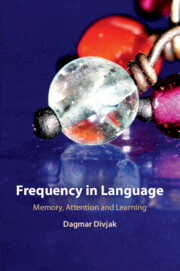Book contents
- Frequency in Language
- Frequency in Language
- Copyright page
- Dedication
- Contents
- Figures
- Table
- Acknowledgements
- Introduction
- Part I
- 1 Counting Occurrences: How Frequency Made Its Way into the Study of Language
- 2 Measuring Exposure: Frequency as a Linguistic Game Changer
- 3 More than Frequencies: Towards a Probabilistic View on Language
- Part II
- Part III
- Part IV
- References
- Index
3 - More than Frequencies: Towards a Probabilistic View on Language
from Part I
Published online by Cambridge University Press: 26 September 2019
- Frequency in Language
- Frequency in Language
- Copyright page
- Dedication
- Contents
- Figures
- Table
- Acknowledgements
- Introduction
- Part I
- 1 Counting Occurrences: How Frequency Made Its Way into the Study of Language
- 2 Measuring Exposure: Frequency as a Linguistic Game Changer
- 3 More than Frequencies: Towards a Probabilistic View on Language
- Part II
- Part III
- Part IV
- References
- Index
Summary
In the previous two chapters we have seen how information about occurrence frequency made its way into research on language and led to the observation that language users are sensitive to the frequency with which forms occur in their linguistic environment. Linguistic theories have built this sensitivity into their foundations, yielding usage-based approaches that dispense with innate structures and instead allow language knowledge to emerge from exposure to usage and to change with usage. We have also surveyed a number of measures that have been used to capture the association between words or between words and constructions.
In this chapter we will explore how frequency of occurrence could support the emergence of structure. Frequencies of occurrence and co-occurrence fluctuate: they are sample-dependent and should hence not be expected to be the same on every occasion. But over time, patterns emerge in these fluctuating (co-)occurrence frequencies.
- Type
- Chapter
- Information
- Frequency in LanguageMemory, Attention and Learning, pp. 72 - 96Publisher: Cambridge University PressPrint publication year: 2019

